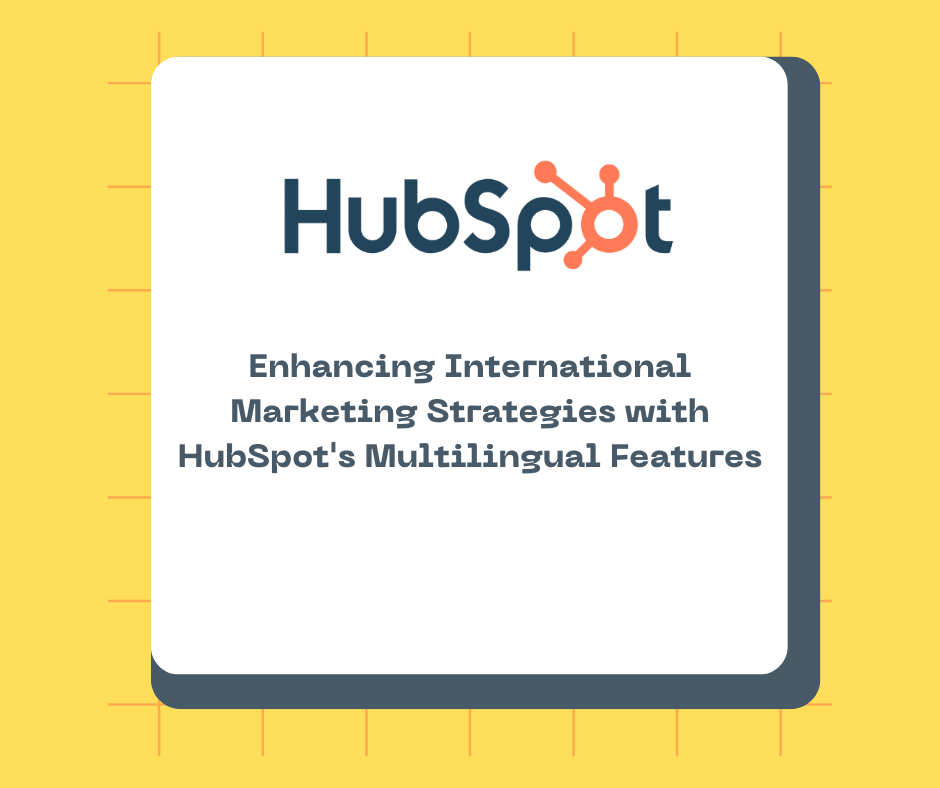In today's globalized world, businesses are increasingly looking to expand their reach beyond domestic borders. International marketing presents unique opportunities and challenges, requiring tailored strategies to engage diverse audiences effectively. HubSpot, a leading inbound marketing and sales platform, offers powerful multilingual features that can help businesses optimize their international marketing efforts. This article explores how companies can leverage HubSpot's multilingual capabilities to enhance their global marketing strategies, reach new markets, and drive business growth.
The Importance of Multilingual Marketing
As businesses venture into international markets, the ability to communicate effectively in multiple languages becomes crucial. Multilingual marketing is not just about translating content; it's about cultural adaptation, localization, and delivering a personalized experience that resonates with different audiences.
Key Benefits of Multilingual Marketing:
- Broader Reach: Access to a wider audience by overcoming language barriers.
- Enhanced Customer Experience: Providing content in the audience's native language improves engagement and trust.
- Increased Conversion Rates: Tailored messaging can lead to higher conversion rates and customer loyalty.
- Competitive Advantage: Differentiating your brand by catering to diverse linguistic and cultural needs.
Leveraging HubSpot's Multilingual Features
HubSpot offers a suite of multilingual tools designed to help businesses manage and execute international marketing campaigns effectively. Here’s how to make the most of these features.
1. Creating Multilingual Content with HubSpot’s CMS
Content is the cornerstone of any marketing strategy. HubSpot’s Content Management System (CMS) supports the creation and management of multilingual content, ensuring that your message is consistent and culturally relevant across different markets.
- Strategy Example: Develop a global content strategy that includes blogs, landing pages, and email templates in multiple languages. Use HubSpot’s CMS to create and manage these assets, ensuring that each version is optimized for local SEO and cultural nuances. For instance, a blog post about a product launch should highlight features that resonate with the local audience and address specific market needs.
2. Localizing Marketing Campaigns with HubSpot’s Marketing Automation
Automation is key to managing complex international marketing campaigns. HubSpot’s marketing automation tools allow businesses to create workflows that cater to different languages and regions, streamlining the process of delivering personalized content.
- Strategy Example: Set up automated email campaigns that are tailored to different language segments. Use HubSpot’s workflow automation to send localized welcome emails, product recommendations, and follow-up messages based on the recipient’s language preference. This ensures that each communication feels relevant and personal, enhancing engagement and conversion rates.
3. Optimizing Social Media Outreach with HubSpot’s Social Tools
Social media is a powerful platform for reaching international audiences. HubSpot’s social media tools enable businesses to schedule and manage posts across multiple languages, ensuring a consistent and targeted presence on global platforms.
- Strategy Example: Create a social media calendar that includes posts in different languages, tailored to the cultural context of each target market. Use HubSpot’s scheduling features to plan and publish content at optimal times for each region. Engage with followers by responding to comments and messages in their native language, fostering a stronger connection with your audience.
4. Enhancing SEO with Multilingual Optimization
Search engine optimization (SEO) is critical for visibility in international markets. HubSpot’s SEO tools support multilingual optimization, helping businesses rank higher in local search results and attract organic traffic from different regions.
- Strategy Example: Conduct keyword research for each target language and incorporate these keywords into your content strategy. Use HubSpot’s SEO recommendations to optimize blog posts, landing pages, and other content for local search engines. Monitor performance with HubSpot’s analytics to identify opportunities for improvement and adjust your strategy accordingly.
5. Leveraging HubSpot’s CRM for Multilingual Customer Relationship Management
Effective customer relationship management is essential for building long-term relationships with international customers. HubSpot’s CRM supports multilingual communication, allowing businesses to manage interactions and track customer journeys across different languages.
- Strategy Example: Use HubSpot’s CRM to segment your customer base by language preference and region. Create personalized communication plans for each segment, ensuring that all touchpoints—from initial contact to post-purchase follow-up—are conducted in the customer’s preferred language. This personalized approach enhances customer satisfaction and loyalty.
Best Practices for Using HubSpot’s Multilingual Features
- Cultural Sensitivity: Understand and respect cultural differences when creating and localizing content. Avoid literal translations and ensure that your messaging aligns with local customs and values.
- Consistent Branding: Maintain a consistent brand voice and identity across all languages. Use HubSpot’s tools to ensure that your messaging is coherent and recognizable in every market.
- Regular Updates: Keep your multilingual content updated to reflect changes in your offerings, industry trends, and customer preferences. Regularly review and refresh your content to stay relevant and competitive.
- Collaborate with Local Experts: Work with native speakers and local marketing experts to ensure that your content is accurate, culturally appropriate, and effective in each target market.
- Monitor and Analyze Performance: Use HubSpot’s analytics to track the performance of your multilingual campaigns. Identify what works well and what needs improvement, and adjust your strategy based on data-driven insights.
Conclusion
For businesses looking to expand their reach and succeed in international markets, HubSpot’s multilingual features offer a powerful solution. By leveraging these tools, companies can create and manage content that resonates with diverse audiences, automate personalized marketing campaigns, optimize SEO for different languages, and effectively manage customer relationships on a global scale. With strategic implementation, HubSpot can help businesses not only overcome language barriers but also build meaningful connections with customers around the world, driving growth and success in the international marketplace.
Schedule your training session here and comment “Need Training” on the request form.

.png?width=1200&length=1200&name=Burger%20Ads%20(Facebook%20Post).png)
Comments